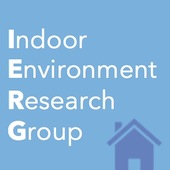The Indoor Environment Research Group conducts experimental and computational modeling projects. It currently has projects funded by the National Science Foundation, ASHRAE, and the Sloan Foundation’s MoBE program. Our projects are organized into three broad topic areas:
Indoor chemistry and aerosol formation and mitigation practices
Many of our projects investigate the secondary organic aerosol (SOA) that is a generated when ozone (O3) and other oxidants react with terpenes and other organic gases (e.g. O3 + terpenes → SOA + others). SOA are airborne particles that are composed of numerous semivolatile reaction products that can partition back and forth between gas and condensed phases. Ozone is largely present indoors due to outdoor-to-indoor transport, and terpenes are directly emitted due to indoor consumer product and cleaner use, as well as by building material off-gassing.
Projects related to indoor SOA formation and its associated indoor chemistry include:
- Indoor aerosols: from personal exposure to risk assessment
- VOC conversion by ozone, hydroxyl radicals, and nitrate radicals in residential indoor air
- Impact of air exchange rates and initial concentrations on SOA from limonene ozonolysis
- Residential SOA and its fraction of fine particle mass and determinants of formation strength
- Indoor SOA initiated from reactions between ozone and surface-sorbed squalene
- Indoor SOA formation initiated from reactions between ozone and surface-sorbed d-limonene
- Predicting indoor SOA mass formation with varying yields
- Indoor SOA formation from ozone reactions with terpene mixtures
- Effect of a portable ion generator on SOA and IAQ in a residential room
- Influence of HVAC system parameters on indoor SOA formation
- Ultrafine particle removal and SOA generation by portable air cleaners
Low energy, IAQ-enhancing sustainable ventilation strategies for buildings
A second thrust of our group investigates how to improve building ventilation, which promotes the comfort and health of building occupants by diluting the concentrations of indoor contaminants. It is often costly in terms of energy consumption, but can also be beneficial from an energy perspective when free cooling is available during colder times. Typically these two cases are controlled by uncoordinated rules: minimum ventilation by fixed rates prescribed by ASHRAE-designated standards (for IAQ), and free cooling by a local controller (for energy). My group currently explores advanced dynamic ventilation strategies working under the hypothesis that combined control that optimizes energy and IAQ objectives simultaneously and dynamically can yield better results in typical buildings than the current, nonintegrated local methods.
Projects related to sustainable ventilation strategies for buildings or associated concepts include:
- Optimal ventilation strategies that improve IAQ and reduce energy use
- Modeling impacts of dynamic ventilation strategies on office IAQ in US cities
- Improving airflow measurement accuracy in VAV terminal units using flow conditioners
- Particle loading rates for HVAC filters, heat exchangers, and ducts
Indoor microbial community response to environmental stimuli
This third area researches responses of indoor bacteria and fungi (collectively called the “indoor microbiome”) to stimuli such as VOC exposure or wetted water damage. This work involves collaborations with colleagues in the Biology Department at Drexel and the University of California - Berkeley.
Projects related to indoor microbiome response to stimuli include:
- Indoor microbial community response to water intrusion events from Superstorm Sandy
- Indoor biofilter microbial community response to VOC exposure
